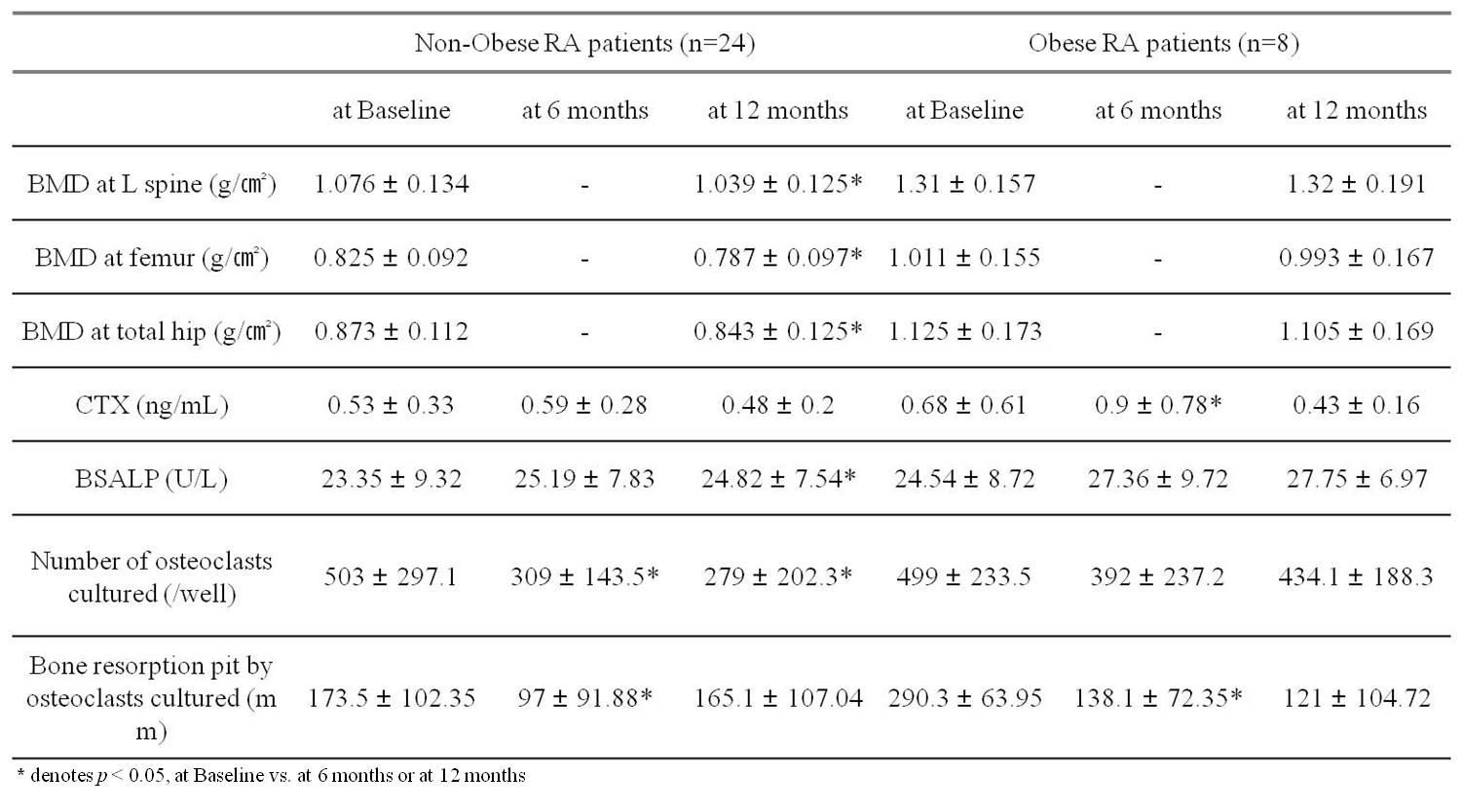Session Information
Date: Tuesday, October 23, 2018
Title: Osteoporosis and Metabolic Bone Disease – Basic and Clinical Science Poster
Session Type: ACR Poster Session C
Session Time: 9:00AM-11:00AM
Background/Purpose:
In this study, we tried to find out the effect of obesity on bone metabolism after one year of anti-TNF agent use.
Methods:
Thirty-two seropositive RA patients were enrolled. They had been refractory to antirheumatic drugs and anti TNF therapies including etanercept, adalimumab and infliximab were administrated for one year. Etanercept, adalimumab and infliximab at approved dose were given to 11, 13 and 8 patients, respectively. Body mass index (BMI) was calculated according to patient¡¯s weight and height at baseline. BMI ¡Ã 25Kg/m2 was considered to be obese. Bone mineral densities (BMD) were measured at baseline and one year after treatment. Blood sampling was done at baseline, 6 months and 1 year after the treatment. Peripheral blood mononuclear cells were cultured and number of osteoclasts was counted. Bone turnover markers including c-terminal telopeptide (CTX), bone specific alkaline phosphatase (BSALP) were measured using enzyme linked immunosorbent assay. In addition, RA disease activity including DAS28 was assessed along with serum level of IL-6.
Results:
After 1 year of anti-TNF treatment, bone mineral density (BMD) in non-obese patients worsened although BMD remained still in obese patients (Table 1). Bone resorption pits by cultured osteoclasts from non-obese patients showed marked reduction at 6 months but seemed to increase at 12 months of treatment despite number of the osteoclasts were continuously decreasing. On the contrary, obese patients failed to show significant change in number of osteoclasts after the treatment but resorption pits by the osteoclasts seemed to decrease in trend. DAS28 improved in both non-obese and obese RA patients and significant reduction of serum IL-6 was noted in non-obese patients (Table 2).
Conclusion:
One year treatment of anti-TNF agent did not change BMD in obese RA patients although there was a significant reduction in BMD in non-obese patients. Number of osteoclasts from non-obese patients decreased after treatment but the function of osteoclasts reflected as bone resorption pit did not respond to the treatment. Despite no change in number of osteoclasts from obese patients after treatment, function of osteoclasts from obese patients seemed to improve, resulting in no change in BMD. Therefore, we believe obesity might positively affect TNF mediated bone metabolism in RA patients.
Table 1. systemic osteoclastogenesis, bone turnover markers and BMD in RA patients after one year of anti-TNF use
Table 2. Systemic inflammation and RA disease activity
|
|
Non-Obese RA patients (n=24) |
Obese RA patients (n=8) |
||||
|
|
at Baseline |
at 6 months |
at 12 months |
at Baseline |
at 6 months |
at 12 months |
|
IL-6 (pg/mL) |
26.17 ¡¾ 31.21 |
17.13 ¡¾ 30.79 |
4 ¡¾ 5.31* |
16.68 ¡¾ 32.53 |
3.08 ¡¾ 5.49 |
7.59 ¡¾ 11.38 |
|
DAS28-ESR |
6.69 ¡¾ 0.83 |
4.53 ¡¾ 1.44** |
3.51 ¡¾ 0.91** |
6.18 ¡¾ 0.79 |
4.38 ¡¾ 1.24* |
3.11 ¡¾ 1.21* |
|
DAS28-CRP |
6.29 ¡¾ 0.72 |
4.13 ¡¾ 1.15** |
3.23 ¡¾ 0.62** |
5.77 ¡¾ 0.81 |
3.91 ¡¾ 0.93* |
3.11 ¡¾ 0.57** |
* denotes p < 0.05, at Baseline vs. at 6 months or at 12 months
**denotes p ¡Â 0.01, at baseline vs. at 6 months or at 12months
To cite this abstract in AMA style:
Lim MJ, Park W, Kwon SR, Jung KH, Lee SY. Obesity Might Positively Affect TNF Mediated Bone Metabolism in RA Patients [abstract]. Arthritis Rheumatol. 2018; 70 (suppl 9). https://acrabstracts.org/abstract/obesity-might-positively-affect-tnf-mediated-bone-metabolism-in-ra-patients/. Accessed .« Back to 2018 ACR/ARHP Annual Meeting
ACR Meeting Abstracts - https://acrabstracts.org/abstract/obesity-might-positively-affect-tnf-mediated-bone-metabolism-in-ra-patients/

